As far as the Colorado Supreme Court is concerned, there is no such thing as "courtroom casual."
In 2001, the Colorado Rules of Professional Conduct were expanded to include a dress code for lawyers. Supporters of the edict claimed that uniforms put an end to office dress-down days which had migrated into courtroom settings.
While some lawyers elect to ignore the practice of professional etiquette, more litigators purposely use their personal style as a form of trial strategy.
Marcia Clark, one of the most recognized female attorneys in the country, found herself in the midst of media mayhem when reporters and analysts began criticizing her skirt length and tightly-permed hair. The prosecutor known for convicting murderers and psychotic criminals was advised by jury specialists to pay more attention to her body language, clothing, and speaking mannerisms.
Consultants suggested that she soothe her image by donning a softer hairstyle and investing in a new wardrobe of more flattering suits.
Polls indicated that the makeover had made her more appealing, which improved her effectiveness in front of live audiences as well as courtroom cameras.
Nancy Wenning is a trial consultant for The Advocates, specializing in communication and trial psychology. With a background in public relations, Wenning believes that women take more of a beating than men with regard to image and personality.
She stated that in one particular trial, a lawyer suffering from a cold continued to sneeze and blow his nose into a handkerchief. Although his actions were uncontrollable, jurors were disgusted by the unsightly condition of the well-used piece of cloth shoved into his pant pocket.
A post-trial review revealed that jurors could not focus on his arguments because of the distracting nature of the sneezing, blowing, wiping, and stuffing routine. In another trial, a female attorney appeared in the courtroom each day well groomed and professionally dressed. In this situation, post-trial interviews indicated that jurors were turned off by the belief that she wasn't feminine.
"Jurors want to see a woman acting and dressing like a woman," Wenning began. "Both male and female jurors, for the most part, are turned off by a woman that they perceive is trying to 'act like a guy'," she said.
With respect to men and women alike, Wenning feels that understanding the jury pool can assist the litigator.
"Jurors expect an attorney to look professional, but the attire should not intimidate the jurors, nor should it scream that the attorney is from a higher economic group than the jurors."
Consultants have long agreed that one of the biggest mistakes attorneys make is the obvious attempt of trying to appear brilliant. Jurors are insulted when a lawyer is combative and belittling to a witness or to opposing counsel. In addition to self-respect, jurors expect lawyers to show sincerity to all parties involved in the case.
This stage presence, which includes eye contact, voice inflection, calm gestures and physical movements, and the craft of persuasive storytelling, rounds out the package of being regarded as a legal celebrity.
Matt Sheppard is a vice-president with Charles Ryan Associates, resident in the agency's Charleston office. He serves as the director of spokesperson training, focusing on media preparedness and other forms of public presentations. Charles Ryan Associates offers litigation support services as part of the company's repertoire, assisting corporate clients with crisis planning and response.
Sheppard analyzed the area's legal talent, pointing out that there are a number of local attorneys who have perfected the art and science of persuasion. He stressed that an attorney's visual impact is important, but the main theme of his or her argument is the part that should be remembered.
"Americans gravitate toward great communicators," he said in a written interview. "It's not just the message, but who is delivering the message that matters. Some of the best in our region include Al Emch, David Flannery and Ellen Cappellanti from Jackson Kelly," he said. "Mike Basile and Niall Paul are both excellent communicators from Spilman Thomas & Battle. Henry Jernigan from Dinsmore and Shohl, and Charlie Love and Tom Heywood from Bowles Rice McDavid Graff and Love are also lawyers who can develop and deliver a message that resonates clearly with their audience."
Courtroom consultants claim that the use of visual aids in a presentation should enhance the main point rather than overshadowing the argument.
However, as Wenning pointed out, jurors tend to equate organizational skills with truth.
"If attorneys come to trial with disorganized charts and files, it makes it tougher for the jurors to believe in them," she said.
The same could be said of a lawyer's image. If it doesn't fit, you must convict.
Kathryn E. (Katy) Brown is the managing member of and the senior writer for The Write Word, LLC. She can be reached at (304) 444-4248 or via email: thewriteword@charter.net.
YOUR LEGAL WRITES: White collar crimes: A lawyer's image gives new meaning to court appearance
ORGANIZATIONS IN THIS STORY

